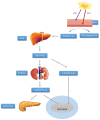The Potential Protective Action of Vitamin D in Hepatic Insulin Resistance and Pancreatic Islet Dysfunction in Type 2 Diabetes Mellitus
- PMID: 26959059
- PMCID: PMC4808876
- DOI: 10.3390/nu8030147
The Potential Protective Action of Vitamin D in Hepatic Insulin Resistance and Pancreatic Islet Dysfunction in Type 2 Diabetes Mellitus
Abstract
Vitamin D deficiency (i.e., hypovitaminosis D) is associated with increased insulin resistance, impaired insulin secretion, and poorly controlled glucose homeostasis, and thus is correlated with the risk of metabolic diseases, including type 2 diabetes mellitus (T2DM). The liver plays key roles in glucose and lipid metabolism, and its dysregulation leads to abnormalities in hepatic glucose output and triglyceride accumulation. Meanwhile, the pancreatic islets are constituted in large part by insulin-secreting β cells. Consequently, islet dysfunction, such as occurs in T2DM, produces hyperglycemia. In this review, we provide a critical appraisal of the modulatory actions of vitamin D in hepatic insulin sensitivity and islet insulin secretion, and we discuss the potential roles of a local vitamin D signaling in regulating hepatic and pancreatic islet functions. This information provides a scientific basis for establishing the benefits of the maintenance, or dietary manipulation, of adequate vitamin D status in the prevention and management of obesity-induced T2DM and non-alcoholic fatty liver disease.
Keywords: HepG2; calcitriol; glucose homeostasis; hypovitaminosis D; insulin secretion; lipid metabolism.
Figures



Similar articles
-
The Modulatory Action of Vitamin D on the Renin-Angiotensin System and the Determination of Hepatic Insulin Resistance.Molecules. 2019 Jul 5;24(13):2479. doi: 10.3390/molecules24132479. Molecules. 2019. PMID: 31284538 Free PMC article.
-
Vitamin D and type 2 diabetes mellitus (D2).J Diabetes. 2013 Sep;5(3):261-7. doi: 10.1111/1753-0407.12024. Epub 2013 May 28. J Diabetes. 2013. PMID: 23302127 Review.
-
Glucose regulation in non-insulin-dependent diabetes mellitus. Interaction between pancreatic islets and the liver.Am J Med. 1985 Aug 23;79(2B):6-12. doi: 10.1016/0002-9343(85)90579-0. Am J Med. 1985. PMID: 2863979 Review.
-
Role of Hypovitaminosis D in the Pathogenesis of Obesity-Induced Insulin Resistance.Nutrients. 2019 Jul 1;11(7):1506. doi: 10.3390/nu11071506. Nutrients. 2019. PMID: 31266190 Free PMC article. Review.
-
Islet dysfunction in non-insulin-dependent diabetes mellitus.Am J Med. 1988 Nov 28;85(5A):4-8. doi: 10.1016/0002-9343(88)90392-0. Am J Med. 1988. PMID: 3057894 Review.
Cited by
-
Association of vitamin D3 and its metabolites in patients with and without type 2 diabetes and their relationship to diabetes complications.Ther Adv Chronic Dis. 2020 Sep 26;11:2040622320924159. doi: 10.1177/2040622320924159. eCollection 2020. Ther Adv Chronic Dis. 2020. PMID: 33062234 Free PMC article.
-
Effects of vitamin D supplementation on insulin resistance and dyslipidemia in overweight and obese premenopausal women.Arch Med Sci. 2019 May;15(3):598-606. doi: 10.5114/aoms.2018.75864. Epub 2018 May 21. Arch Med Sci. 2019. PMID: 31110524 Free PMC article.
-
The Modulatory Action of Vitamin D on the Renin-Angiotensin System and the Determination of Hepatic Insulin Resistance.Molecules. 2019 Jul 5;24(13):2479. doi: 10.3390/molecules24132479. Molecules. 2019. PMID: 31284538 Free PMC article.
-
Asthma Phenotype with Metabolic Dysfunction.Yonsei Med J. 2022 Jan;63(1):1-7. doi: 10.3349/ymj.2022.63.1.1. Yonsei Med J. 2022. PMID: 34913278 Free PMC article. Review.
-
The associations of vitamin D status and dietary calcium with the metabolic syndrome: an analysis of the Victorian Health Monitor survey.Public Health Nutr. 2017 Jul;20(10):1785-1796. doi: 10.1017/S1368980016001609. Epub 2016 Jun 24. Public Health Nutr. 2017. PMID: 27339376 Free PMC article.
References
-
- Black D.D. Hepatobiliary physiology. In: Leung P.S., editor. The Gastrointestinal System. Springer; Berlin, Germany: 2014. pp. 237–324.
-
- Nwosu B.U., Maranda L. The effects of vitamin D supplementation on hepatic dysfunction, vitamin D status, and glycemic control in children and adolescents with vitamin D deficiency and either type 1 and type 2 diabetes mellitus. PLoS ONE. 2014;9:147. doi: 10.1371/journal.pone.0099646. - DOI - PMC - PubMed
Publication types
MeSH terms
Substances
LinkOut - more resources
Full Text Sources
Other Literature Sources
Medical

